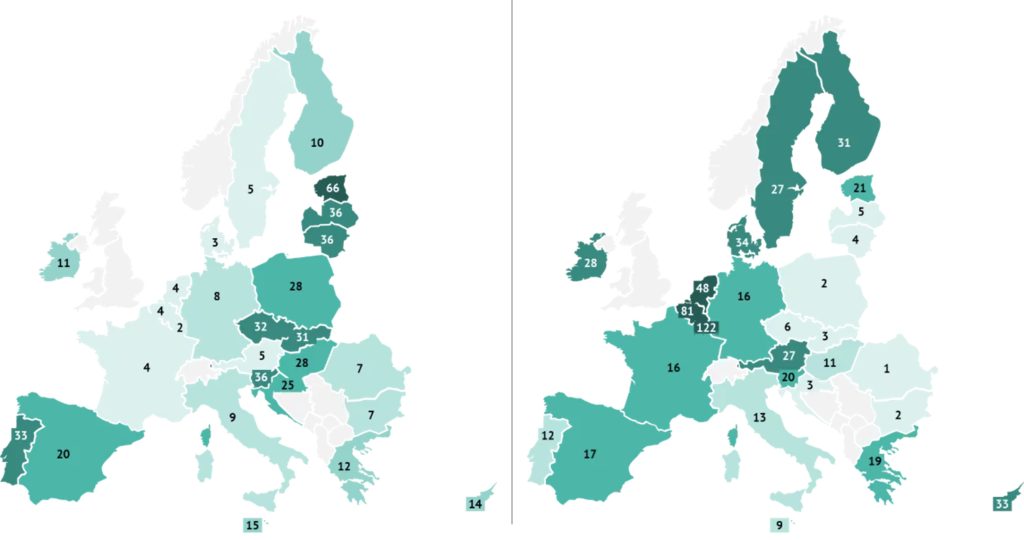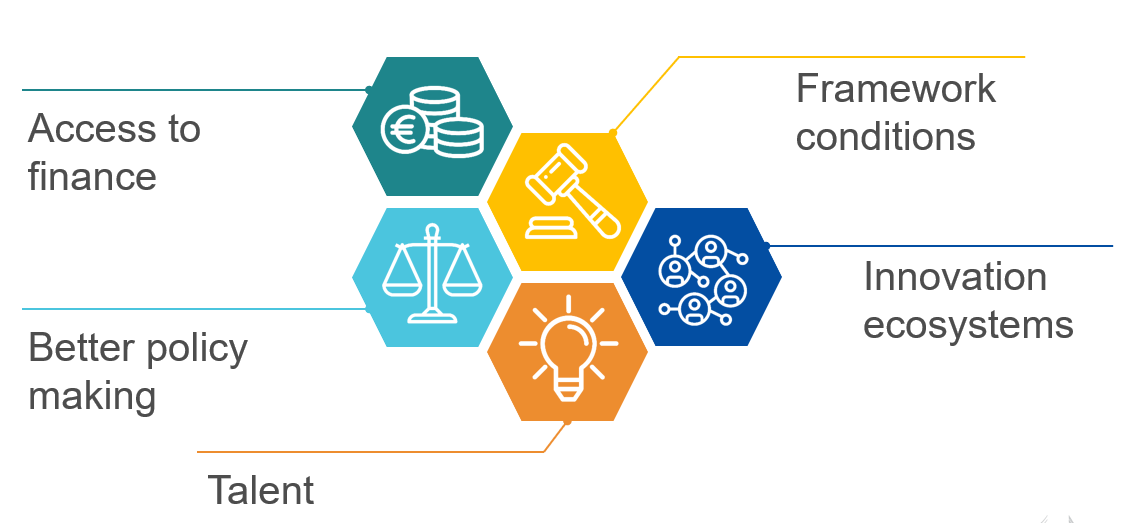The webinar, steered by Pál Belényesi, included four panelists:
- Bence Kováts, PMO Director at Századvég Konjunktúrakutató;
- András G. Inotai, Head of Unit of Innovation Policy and Access to Finance, DG Research and Innovation, European Commission;
- Bohumil Kartous, Director of the Prague Innovation Institute; and
- Péter Lábody, Vice President of Legal, International and Innovation Affairs at the Hungarian Intellectual Property Office.
Main take-aways from the event:
- It is key to strengthen innovative ecosystems, especially at local levels, and to go beyond the focus of financial support.
- As part of the new European Innovation Agenda, to be published within a month, the European Commission plans to focus on five areas: finance, framework conditions, better policymaking, talent and innovation ecosystems.
- It is key to encourage projects which are not yet known (i.e. non-existing projects. Education needs to focus on inspiring young people to take risks.
- In the past 10 years, the composition of corporate assets changed fundamentally: today intangible assets far outweigh tangible ones and therefore the protection of intellectual property plays an ever more important role.
The European Commission recently ran a public consultation as a call for evidence for the new European Innovation Agenda. The policy under development aims to better interconnect the European innovation ecosystem and bridge the innovation divide between the Regions and the Member States of the EU.
The first panel member, Bence Kováts presented the experience of Századvég Konjunktúrakutató in this relation, including looking at the current incentive landscape and the key lessons advisors come across in the topic locally.
When looking at the total added value of companies per capita in the different Member States, a large difference is seen within Europe. In connection to this, the importance of innovation needs to be stressed upfront: innovation’s spillover and multiplier effects enhance not only the performance of the particular companies carrying them out, but also of their regions, their Member States, and that of the EU.
When supporting innovation, ESIF[1] plays a key role, especially in Central and Eastern Europe. These funds are further complemented by other types of support in the CEE Member States, such as National Innovation Funds, the Recovery and Resilience Facility and funding for startups through VC facilities.
Annual funding per capita 2014-20 (EUR), ESIF TO1 / Common Strategies Framework – Research and Innovation

However, when looking at the Research and Innovation funding of the Common Strategic Framework (i.e. Horizon 2020 and Euratom), it is clear, that the CEE Members States focused far less on this type of EU support. With this, however, the spillover effect of this European innovation know-how is far less tangible in those countries, where it can reach its largest effect.
To enhance the European innovation approaches, two key areas for intervention can be identified:
- the streamlining of European innovative initiatives; and
- to reach out to local entities (e.g. SMEs with no national-international presence), who likely bear the largest potential for corresponding growth.
András Inotai highlighted that in the course of developing the new European Innovation Agenda, five areas were identified that need additional provisions.
- The startups in Europe are doing well and the number of Unicorns has doubled in 2021. The challenges of access to finance, however, are primarily present with regards to capital (incl. patient capital, VC and IPOs) and tax incentives aimed at the high-risk tech sector. The Commission is considering how to utilize the available resources to facilitate private funding of innovation activities, help the large-scale deployment of private and public funds, increase targeted investments and strengthen the use of IP rights.
- The development of framework conditions needs to focus on strengthening the Single Market and uniting the regulatory environment, while supporting the taking of risk, for example, through introducing experimental clauses and fostering regulatory sandboxes, living labs and test beds.
- The EU can also help the Member States with some technical support instruments, which can facilitate, for instance, the procurement of innovation. A key area for better innovation policy making are therefore national frameworks and strategies for innovation procurement processes. Also, it is key to strengthen the existing information base in order to be able to target policy support and to improve coordination, for example, through the European Innovation Council Forum.
- Talent and skill shortages are still present in Europe as brain drain is ongoing by other global innovation centres. It is key to retain talent and facilitate an entrepreneurial mindset and skills for our experts here at home. Encouraging further cooperation between research organisations and industry remains ever important. The EU blue card directive, for example, will also provide help the EU member states to attract talent from third countries.
- When looking at local innovation ecosystems, the innovation divide between the European regions has increased over the past years. This is due to several reasons, including the deficiency of innovation reforms and investments; the critical situation of policy reforms; the lacking modernization of scientific and innovation institutions; and weak administrative capacity in certain regions. Especially the European Innovation Ecosystem program, that explores how these ecosystems can be more developed and better connected, may play an important role in the new European Innovation Agenda.
Bohumil Kartous presented the current situation in the Czech Republic, where local innovation centres have been launched nationwide in recent years. These centres, as the Prague Innovation Institute itself, are owned and funded by the local governments and universities. These institutes support existing businesses and start-ups also and trying to cooperate with them and with other partners, focusing on projects which are only in the making.
It is key to build bridges between the formal and informal education ecosystems. To achieve this, several examples on how the local innovation ecosystem is strengthened in Prague, were highlighted, for example:
- Working on spotting niches with which they can support intellectual property rights.
- Organizing start-up nights, where with the participation of the five universities of Prague try to invite those students and fresh graduates who would like to implement their projects.
Mr. Péter Lábody, presented the role and potential of intellectual property rights which goes hand in hand with innovation.
An important global corporate trend to be pointed in this respect is the internal share of assets: while in the 1970s the market value of companies was primarily defined by their tangible assets (i.e. machines, buildings, fleet and real estate), nowadays this trend changed and intangible assets (i.e. patents, design, brand, software, professional skills, know-how) far overweight others in the market value of today’s companies.
Three main areas of intellectual property (IP) were highlighted:
- the protection of innovations;
- the commercialization of innovations and to do that it is important to cover our innovation with legal protection package; and
- the help of the transformation of innovations into intangible assets.
The number of those who protect their innovations is especially low in Hungary. Therefore, the Office launched several initiatives, such as its free IP scan service to SMEs.
You can watch the event’s recording here:
Századvég Konjunktúrakutató is a member of the Századvég Group. As a key player in the domestic advisory market it seeks to support public administration and businesses in the private sector in their policy-making and strategic operations with its knowledge, experience and approach. Its eight business units are: development policy, education and innovation, digital economy, social research, energy and climate, health, macroeconomics and rural development. Századvég’s policy expert capacities are complemented by its primary research capacities, which use multiple qualitative and quantitative methodologies, including recent surveying technologies such as social listening or eye tracking analyses.
[1] European Structural and Investment Funds


